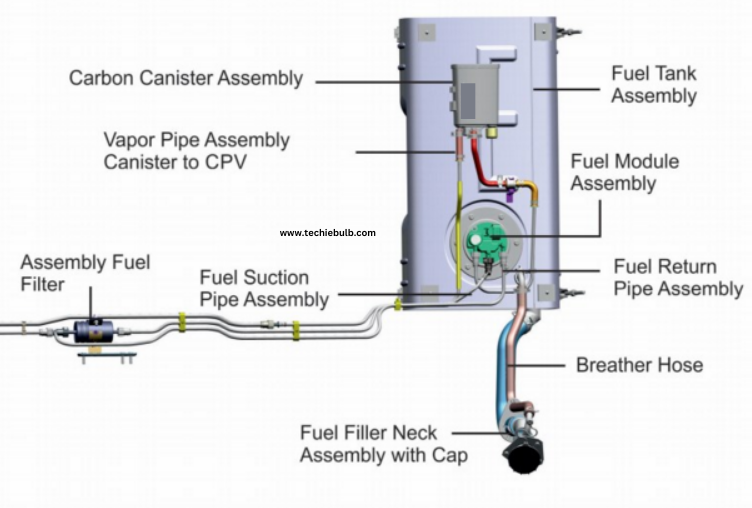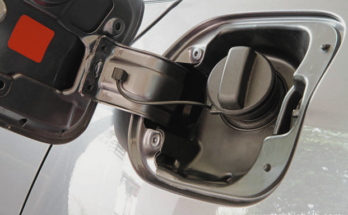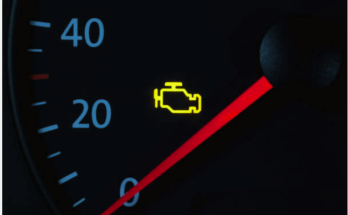Have you ever noticed the check engine light blinking on your dashboard? If so, you’re probably wondering what’s causing it. It’s common for check engine lights to come on when there’s an issue with your vehicle’s evaporative emission control (EVAP). P0455 code is one of the most common causes of this warning.
What is EVAP? EVAP stands for Evaporative Volatile Air Propellant. It’s a system that captures and stores fuel vapors from your fuel tank, preventing them from leaking into the atmosphere.
When there’s a large leak in your EVAP system, it can cause an increase in emissions, which can also have an impact on the performance of your vehicle.
The P0455 code can be caused by a number of factors, but it is important to identify and diagnose the root cause of the issue. The most common causes of P0455 code include: Loose or damaged fuel cap Cracked or disconnected EVAP hose Faulty EVAP purge valve Failing EVAP canister.
In our next blog series, we will look at the causes, symptoms and diagnostic procedures of P0455. We will also talk about the importance of fixing this issue as soon as possible to keep your vehicle clean and running optimally.
Stay tuned as we reveal the secrets behind P0455 and give you the knowledge and tools you need to maintain your vehicle’s performance.
CODE: P0455
DISCRIPTION: System Gross Leak Evaporative Emission OR Evaporative Evaporative Emission System Large Leak Detected
What is the DTC Code P0455?
The DTC (Diagnostic Trouble Code) P0455 is a generic OBD-II code that indicates a significant leak in the evaporative emission control system (EVAP) of a vehicle. This system is responsible for capturing and storing fuel vapors from the fuel tank to prevent them from escaping into the atmosphere, reducing harmful emissions.

When the EVAP system detects a large leak, it triggers the check engine light and stores the P0455 code in the vehicle’s onboard diagnostic system.
This code signals that there is a leak in one of the components or hoses within the EVAP system, allowing fuel vapors to escape.
It’s important to address the P0455 code promptly because ignoring it can lead to more pollution, lower fuel efficiency, and potentially damage other parts of your car’s EVAP system.
So, if you see the check engine light come on and get a P0455 code, it’s best to have it checked out as soon as possible to keep your car running smoothly and minimize its impact on the environment.
Possible Causes of DTC Code P0455
Common causes of the DTC P0455 code include a loose, damaged or missing EVAP fuel cap, a cracked or disconnected EVAP system hose that allows for leaks, a faulty EVAP purification valve that controls fuel vapors flow, and problems with EVAP canisters that store fuel vapors so they can’t be used by your engine.
To fix the DTC code, you’ll need a qualified mechanic who uses diagnostic equipment and knows what they’re doing.
A Faulty or loose fuel cap: A fuel cap that is loose, damaged or missing can be one of the main causes of P0455. A fuel cap is an important part of an EVAP system. If the fuel cap is not sealed properly, it can leak fuel vapors which can trigger the code.
Cracks or Disconnections in EVAP hoses: EVAP is a complex system of hoses and a series of lines. Over time, some of the hoses can crack, break or disconnect, which can cause leaks in the system and result in P0455.
Problems with the EVAP purge valve: The purge valve controls how the EVAP fuel vapors flow from the canister up to the engine’s intake manifold. Malfunctioning or getting stuck open can cause a massive leak in the entire EVAP system.
Leaks in the canister: The canister stores the EVAP fuel until it can be purified by the engine, but if the canister becomes saturated with the EVAP fuel it can cause P0455.
Cracked or damaged EVAP Lines: The EVAP system consists of various lines and connections. These can be damaged by external factors or by wear and tear. If these lines crack, break, or are damaged, they can lead to leaks and the activation of the P0454 code.
Inaccurate EVAP Pressure Sensor: If the EVAP system includes a pressure sensor, it is important to keep an eye on the system pressure level. If the sensor malfunctions or gives inaccurate readings, the leak detection system will not be able to detect the leak and the code will be triggered.
What are the P0455 code possible symptoms?
The P0455 code typically triggers the check engine light on the vehicle’s dashboard, indicating a problem with the evaporative emission control system (EVAP). While the code itself doesn’t cause any noticeable performance issues, there may be some symptoms associated with it:
Check Engine Light: The most common symptom of the P0455 code is the illumination of the check engine light on the dashboard. This serves as a warning that there’s a problem with the EVAP system and should be addressed promptly.
Fuel Odor: A noticeable fuel odor inside or outside the vehicle may indicate a significant leak in the EVAP system. Fuel vapors escaping from the system due to a large leak can result in a strong smell of gasoline.
Decreased Fuel Efficiency: In some cases, a significant leak in the EVAP system can lead to decreased fuel efficiency. This occurs as fuel vapors escape instead of being properly contained and utilized by the engine, resulting in wasted fuel.
Rough Idle or Stalling: In rare instances, particularly if the EVAP purge valve is stuck open, there may be a slight impact on engine performance, such as rough idling or stalling. This is more likely to occur if the issue causing the P0455 code is severe or has been present for an extended period.
Emission Test Failure: If the vehicle undergoes an emissions test while the check engine light is illuminated due to the P0455 code, it will likely fail the test. This is because a malfunction in the EVAP system can lead to increased emissions, which may exceed regulatory limits.
While these symptoms can indicate a problem with the EVAP system and trigger the P0455 code, it’s essential to conduct a thorough diagnosis to pinpoint the exact cause of the issue and ensure proper repair and resolution.
Ignoring the check engine light or associated symptoms can lead to further complications and potential damage to the vehicle’s emission control system.
How do I fix the DTC Code P0455?

Fixing the DTC (Diagnostic Trouble Code) P0455 requires identifying and addressing the underlying issue causing the significant leak in the evaporative emission control system (EVAP). Here’s a step-by-step guide to resolving the P0455 code:
Check the Fuel Cap: Start by inspecting the fuel cap to ensure it is properly tightened and sealed. A loose, damaged, or missing fuel cap is a common cause of the P0455 code. If the fuel cap is faulty, replace it with a new one designed for your vehicle.
Inspect EVAP Hoses and Lines: Examine the EVAP system hoses and lines for cracks, breaks, or disconnections. Pay close attention to areas where hoses connect to components such as the EVAP canister, purge valve, and fuel tank. Replace any damaged hoses or lines as needed.
Check the EVAP Purge Valve: Test the EVAP purge valve to ensure it is functioning correctly. The purge valve controls the flow of fuel vapors from the EVAP canister to the engine intake manifold. If the valve is stuck open or malfunctioning, it can cause a significant leak. Replace the purge valve if necessary.
Inspect the EVAP Canister: Check the EVAP canister for signs of damage or leaks. The canister stores fuel vapors until they can be purged by the engine. If the canister is saturated with fuel or has developed a leak, it can trigger the P0455 code. Replace the canister if it is damaged or faulty.
Test the EVAP System for Leaks: Perform a smoke test or pressure test on the EVAP system to identify any leaks. A smoke machine introduces smoke into the system, making it easier to locate leaks visually. A pressure test checks for leaks by pressurizing the system and monitoring for pressure drops. Repair any leaks found during testing.
Clear the DTC: After addressing the underlying issue causing the P0455 code, use an OBD-II scanner to clear the code from the vehicle’s onboard computer. This resets the check engine light and allows you to monitor the system for any new faults.
Monitor for Recurrence: After clearing the code, monitor the vehicle for any recurrence of the P0455 code. If the code reappears, it may indicate that the issue has not been fully resolved, and further diagnosis and repair are necessary.
Diagnostic Cost of DTC Code P0455
The diagnostic cost for a DTC (Diagnostic Trouble Code) like P0455 can vary depending on several factors such as your location, the specific vehicle make and model, and the rates charged by the mechanic or dealership.
Generally, diagnostic costs for a code like P0455 can range from $50 to $150. This fee typically covers the time and labor required for a technician to use diagnostic equipment to pinpoint the cause of the code.
However, it’s important to note that the diagnostic cost is just for diagnosing the issue. The actual repair cost will depend on what is causing the significant leak in the evaporative emission control system (EVAP), as indicated by the code.
Repair costs could vary widely depending on the specific component that needs to be replaced or repaired, as well as any additional parts or labor required.
It’s advisable to communicate with your mechanic or service provider to understand their pricing structure and what the diagnostic process entails. Additionally, they can provide you with an estimate for the repair costs once the diagnosis is complete.
Keep in mind that addressing the DTC code P0455 promptly is crucial to prevent further emissions issues and potential damage to your vehicle’s EVAP system.
Conclusion
Ignoring P0455 DTC code can result in increased emissions, poor fuel economy, and even damage to your vehicle’s EVAP. Understanding the causes, signs, and solutions can help you fix the problem quickly and keep your vehicle running eco-friendly and in good working order. If you’re not sure how to diagnose or fix P0455, it’s best to seek professional help from a mechanic or auto technician.




